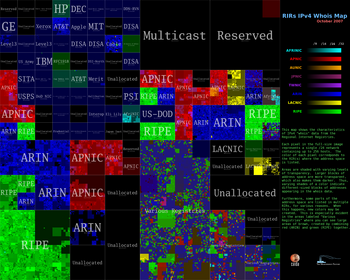IPv4 WHOIS Map
Background
The process of domain registration was originally described by RFC 920: Domain Requirements which specifies the requirements for establishing a domain in the ARPA-Internet and the DARPA research community. DARPA handled the registration process, via Jon Postel at the Information Sciences Institute, and maintained a single database. During this period, many "legacy" allocations were made. These appear primarily in the upper left quadrant of the image below.
In 1993, during the period when the National Science Foundation funded and maintained the NSFnet, management of the database moved to InterNIC which consisted of Network Solutions, Inc, General Atomics, and AT&T all sharing responsibility for the domain registrations and database maintenance.
In 1999, the Internet Corporation for Assigned Names and Numbers (ICANN) took over management of the top-level domains (TLDs) including .com, .net, and .org and oversight of the Internet Assigned Numbers Authority (IANA). Today, IANA oversees the allocation of globally-unique IPv4 and IPv6 addresses and Autonomous System numbers. IANA delegates the downstream registration of these finite address and number block resources to Regional Internet Registries (RIRs) that correspond to five major regions in the world. Some of the RIRs further delegate to Local Internet Registries (LIRs).
Mapping the WHOIS Prefixes in IPv4 Address Space to Regional Internet Registries (RIRs)
Each pixel in the full-size image represents a single /24 network containing up to 256 hosts. The color of each pixel corresponds to the RIR(s) where the address space is listed.
Areas are shaded with varying levels of transparency. Larger blocks of address space are more transparent, which also makes them darker. Thus, varying shades of a color indicate different-sized blocks of addresses appearing in the whois data.
Furthermore, some parts of the address space are listed in multiple RIRs, for various reasons. When this happens, new colors may be created. This is especially evident in the areas labeled "Various Registries" where you can see large areas of brown, created by combining red (ARIN) and green (RIPE) together.
Address blocks are labeled based on IANA's list of IPv4 allocations. Early recipients of large "class A" address blocks appear in the upper left, while the areas labeled Various Registries indicate allocations from the former "class B" and "class C" regions. Since the mid-1990's all address space allocations are now made through the Regional Internet Registries: RIPE, APNIC, ARIN, LACNIC, and AfriNIC.
This visualization of the characteristics of IPv4 WHOIS data was created by The Measurement Factory under subcontract to CAIDA.
WHOIS Data
The WHOIS data comes from the five Regional Internet Registries (RIRs).
- African Network Information Center (AFRINIC) for Africa
- Asia Pacific Network Information Centre (APNIC) for Asia and the Pacific Region
- American Registry for Internet Numbers (ARIN) for North America
- Latin American and Caribbean Internet Addresses Registry (LACNIC) for Latin America and the Caribbean
- RIPE Network Coordination Centre (RIPE NCC)for Europe, the Middle East, and Central Asia


